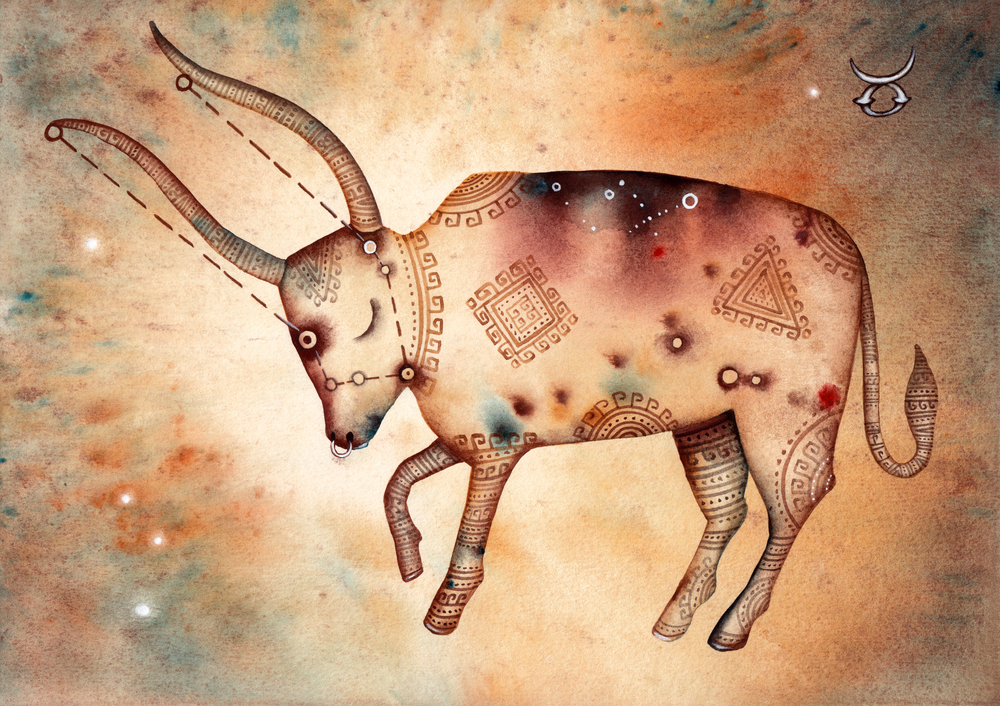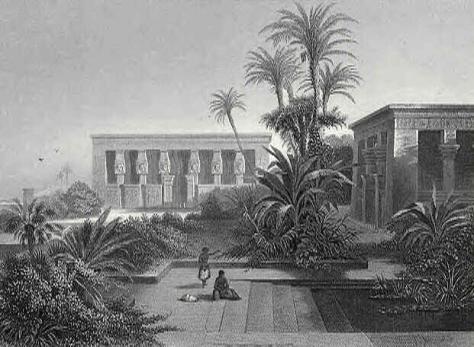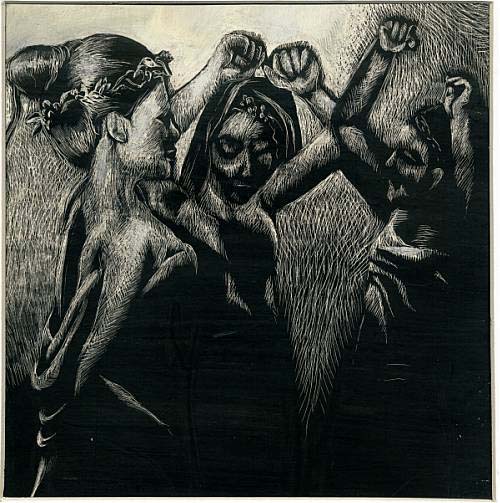
Date of Rulership: 21st April-20th/21st May; Polarity: Negative, Female; Quality: Fixed; Ruling planet: Venus; Element: Earth; Body part: Throat and Neck; Colour: Pink; Gemstone: Sapphire or emerald; Metal: Copper.
The explosive impulse that is epitomised by the zodiacal sign of Aries is steadfast followed by Taurus, a stellar bull which appears to straddle the horizon between vernal equinox and the summer solstice. Taurus is the celestial power most suitable to successfully harnessing the fiery potentiality of new life sown by Aries because of the unwavering strength, determination, and commitment it introduces into the cosmic meme pool. Looking at the sign from a purely suprapersonal and cosmogenic perspective, one could say that its position in the sky mirrors its symbolic and metaphysical locus as an ethereal apparatus of transmutation that directs an evolution of fiery energy set forth on the wheel of creation by spontaneous Arian generation. Just as the constellation of Taurus embraces the sun between the vernal equinox, a position of birth, and summer solstice, a position of maturation and the echelon of development, so too does the respective formative force behind the veil of stellar appearances guide the vital life-force of an organism to maturation or dismemberment and dissolution.
Taurus is second in a line of archetypal children born to the grandiose multiverse. Whereas Aries is descended of ethereal fire, the configuration of stars belonging to Taurus were crystallised beneath ethereal earth. “Of course we all know that Aries is the first born,” says Taurus from its place in heaven, “though being first at anything doesn’t necessarily mean you’re the best at it. Let’s not forget the great pains Mother Nature endured at the merciless hands of trial-and-error to perfect the complex thread of all intelligent Life. Aries may be impulsive, combustive and creative like raging fire, but the conditions for Life to accomplish its means requires calculated, controlled and mediated options and controls. Sure, you can plant seeds in the firestorm of Arian motion that is spring but you can be certain that they’ll wither and die by summer if you don’t stay the course and nourish them accordingly. In any case, Aries operates at lightning speeds and overlooks the finer fruits and flavours dangling from the Tree of Life. No kidding, we’re talking about a complete absence of the aesthetic. I guess that’s just too bad for Aries, huh?”
From this brief soliloquy regarding his older sibling one might deduce Taurus to be a level-headed, logical and intensely practical state of being. By modestly applying the laws of analogy we can at once understand the fundamental makeup of the Taurean psyche. Taureans, for the most part, are like self-taught, disciplined and autonomous little horticulturists. They come equipped with antediluvian knowledge pertaining to lunisolar cycles, lunar nutation, the seasons, and axial precession, and understand how these cosmic cycles can be used in conjunction with soil mix and fertiliser to garner superior natural products. For them, perfection is a work-in-progress and patience is a virtue. Their understanding and contemplation of unseen forces that link the Great Above and the Great Below is indispensable, for it prompts only those calculated moves and actions that will secure prolific results. Their propensity to spend a vast portion of the day connected to the ground, communing with friends of earth, and tending to them indicates a profound respect for and harmonious integration with Mother Nature, an intense awakening and awareness of their carnal appetites, and an unconscious instinct to mother, insulate and protect other beings irrespective of their phylogenetic kingdom. Generally speaking, these people are really good at working diligently to achieve material success in a relaxed and tranquil environment without entangling themselves in the mental landmines of past or future. They want everything to be concrete, fixed, practical, and predictable, sometimes to such an extreme degree that Life is made to resemble a ticking automaton void of individual expression, mental activity and “soul”. This is exactly what the Taurean psyche is about!
Apuleius, a second-century Latin writer, transcribed the Taurean archetype well when he penned the mythological narrative, Cupid and Psyche. In the fanciful tale, Cupid, the masculine prototype of Divine Love, falls victim to the potency of his own arrows and becomes enamoured of Psyche, a mortal princess. The entire narrative revolves around two antagonistic concepts; Psyche’s betrayal of Cupid’s trust and his mother’s (Aphrodite) disapproval of their relationship. Unsurprisingly the suspenseful barrage of frontiers intending to keep the lovers separated permanently is futile, and the tale concludes happily with the two beings united in Olympian matrimony. With respect to the figure of Cupid, Apuleius paints the picture of a man under the mediation of the feminine aesthetic. First impressions are also lasting, for he falls in love at first sight. From this point onwards Cupid brands the mortal Psyche his personal fiefdom and hopes to hold onto her for all eternity. Just like all love-struck individuals, he becomes physically and emotionally dependent. His meticulous efforts to fabricate lasting homely conditions delineates the condition of a soul which never veers from its path, a sentiment which stays intact even after Psyche’s act of duplicity. Here, we see a fiercely faithful and committed Cupid. No doubt the self-respect and value, as well as the sense of worth and spiritual status-quo that emanate from Love comprise foremost of the reasons why a temporary separation between the two eventuated. But the inflicted wound wasn’t significant enough to tear them apart forever and they were eventually reunited. Through the text the audience is also inclined to view Cupid as in instinctual being, a man whose actions and reactions were based on intuition and face value rather than intellectual evaluation. Cupid’s immense focus on attaining the object of his desire, his patient determination, his acute sensitivity, and his stubborn resolve in surmounting all odds stacked against him typify all Taureans.
Taureans can thank their lucky stars–quite literally in fact–for the intercession and ascendency of the Venusian sphere in the otherwise primal, unrefined and unyielding breeding ground urgently generated by the disposition of the bull. One can safely declare that Taurus would have been far too inert, selfish and utilitarian in its ways to enable progress and psycho-spiritual evolution had it not been for the pre-eminence of the celestial goddess. The graceful and supernal Venus dresses the scruffy-looking and unshaved Taurus in the manner that an affluent queen might dress a peasant lover in exquisite garments in order to pass him off as gentry. The latter is symbolic of the qualities of sensual love and is blessed by a holistic and integrated approach to life; she spends an awful lot of time procrastinating and prevaricating in order to satisfy her compendium of relationships and willingly compromises as to avoid altercations and war. In addition, Venus proceeds along a mode of being that is cultured, graceful, constructive, refined, resourceful and providentially productive; she is unconsciously programmed to preserve and celebrate the miracle of Life through art cleaved by spontaneous rebels and social misfits. These productive and benevolent energies diffuse into the psyche of the archetypal bull through a psychic conduit formed by fixed, earthy qualities indigenous to both. Venus operates through the ground and Taurus is always grounded, making the psychic transmission an autonomous and spontaneously-driven affair. Hence, Taurus can thank the Venusian powers for its inclination to seek gratification through the bodily senses, its inherent desire for serenity and physical contact, its occasional flippancy, its appreciation of music, and its conscientious attitude towards physical appearance and maintenance. Venus harnesses the soothing Taurean temperament.
In a nutshell the Taurean archetype strengthens the unconscious will through a self-disciplined and single-handed concentration of vital energies. There are innumerable virtues associated with this instinctual act, namely the capacity to commit, to persevere, and to take premeditated actions. This inevitably leads to an accumulation of material or spiritual assets, an inheritance that almost always rouses a concomitant Taurean propensity to nurture, to protect, and to hold onto things. Perhaps the latter is also its greatest detriment; when entrenched in the stability of its own habits for extended periods of time, Taurus can become painstakingly predictable and overindulgent, uninventive, inflexible, stubborn, and fiercely resistant to providential change. Resistance to change can be destructive, counteractive and soul-shattering for this sign. Nevertheless, the Taurean “soul” encompasses a potential rarely illumined in the other zodiacal beasts, one that can inevitably flower into an insoluble psychic force if it endears itself to versatility.
Like Aries, there are also two symbols associated with the zodiacal sign of Taurus. The first is a pictorial representation of the entire bull; the second, a shorthand version utilised by astrologers in the creation of horoscopes, is comprised of only the head and horns. The design of the glyph is not coincidental; there is an inherent meaning and understanding communicated through its fundamental shape. Head and horns allude to masculine differentiation and virility, but in a feminine context. Taurus is invariably mediated by the formative energies of the Venusian sphere, meaning that any sharp and proactive masculine qualities expressed by the Taurean archetype are softened and tamed considerably. While it may be a beast of insoluble strength and willpower, its susceptibility to domestication and enslavement to more evolved extensions of Mother Nature illuminates this eternal subordination to the Great Mother. The shorthand glyph resembles a larynx, a phenomenon reminiscent of the sign’s sovereignty over the throat region of the human being. As an implement of comprehension, the larynx offers a conduit into the sensory world of sound, music, and language, linking the realm of matter and physical senses with the immaterial world of mental forms and intellectual comprehension. In retrospect, the symbols fit the sign’s inherent nature like a glove.









